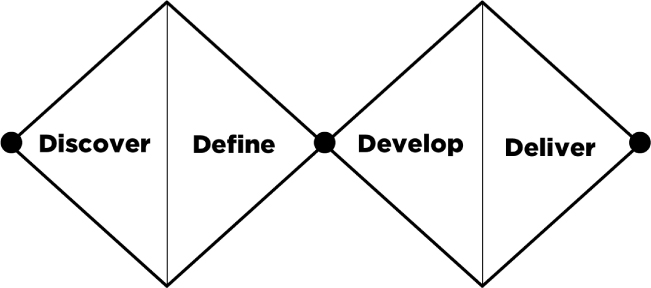TUTORIAL DESCRIPTION
It’s no news that human-centered innovation has become a common internalized practice of many organizations around the world. In the last decade, companies have begun developing their own innovation departments in addition to building teams to tackle new, complex business challenges—often employing the Double Diamond design process in these endeavors.1
The Double Diamond design process was mapped by the UK Design Council in 2007 through an in-depth study of the design processes used in eleven global brands. Divided into four distinct phases, it maps the divergent and convergent stages of the design process to illustrate the different modes of design thinking.2
The Discover phase serves to gather inspiration to develop new solutions through ethnography and several research methods. Throughout INSITUM’s many years of helping hundreds of companies develop their human-centered innovation culture, we have come to the realization that most innovation teams view the Define phase as a black box, wherein the “magic happens” and valuable insights are created. Although crucial to ethnographic research, the analysis stage is still somewhat hazy; teams can over-rely on design toolkits and oversimplified techniques to make sense of what was seen and heard during fieldwork—rather than considering the many steps of the analysis process, the context, or the audience of the research.
This tutorial was designed to help participants carefully plan and select methods for each stage of the analysis process in order to center the decision-making on the research context and audience profile. To facilitate this, the Define phase is divided into 4 main stages:
- Organize: Go through raw research data and extract information in an organized and structured way.
- Interpret: Deep-dive into the downloaded information to understand the context behind the findings.
- Synthesize: Transform and summarize the interpreted information into structured models that allow for comparison and further interpretation of data.
- Present: Define how the analyzed data will be visualized and presented to its audience.
To define the methods in each stage, a structured planning session is carried out after fieldwork to plan ahead for analysis: it showcases how information will be organized, used for analysis, and what will be delivered. In this session, the project team first maps their project and research context. This is broken down into highlighting objectives and methodology (project/research goals and research methods), client and audience (organization background, direct client involvement during the research and analysis, and final audience profile), and resources available for analysis (fieldwork outputs, people involved, and time). Once the context is mapped, the team analyzes each of the stages individually using a 3-step process:
- Criteria definition: Based on the mapped context, the team prioritizes and defines the two most important criteria that will be used to decide which analysis methods will be more impactful to the project (eg. if the method reveals relationships, allows different data crossing, fosters collaboration etc.).
- Methods mapping: By using the previously defined criteria as the axis of a 2×2 matrix, the team maps potential methods and techniques for that analysis stage (eg.: analytical debriefs, meaning definition, customer journeys etc.).
- Methods definition: The team then analyzes the map of methods according to variables and selects one or a combination of methods that will be used during the analysis stage.
The structured analysis planning session helps teams not only decide between methods and techniques that will be used for analysis, but also fosters discussion about the project context and potential outcomes. These reflections are often as important as the decision regarding which methods should be used. Analysis tends to be a chaotic activity, and this planning session helps to keep everybody on the same page.
Marcelo Fagundes is a postgraduate lecturer in Design Research at Insituto Europeo di Design and Account Manager at INSITUM, where he helps Fortune 500 companies identify innovation opportunities and transform them in impactful projects. He also has worked as a design strategist at the technology consultancy MJV integrating business, technology and human-factors to design services and strategies for the Brazilian government and private companies. He holds a degree in design from the Sao Paulo University of Fine Arts an was the Local Communications Chair of EPIC 2015.
Murilo Gomes was originally trained in Industrial Designer with emphasis on Products. He has been working in user centered innovation at INSITUM since 2010, and currently leads multidisciplinary teams conducting innovation projects for new services and products, strategic development and digital interaction for numerous companies such as Telefonica, Avon, Intel, Google, Facebook, Bosch, Panasonic, Samsung, Sony, Itaú, and others. He also serves as head of internal capacity management at INSITUM, mapping and developing internal expertise.
NOTES
1 Jon Kolko, Design Thinking Comes of Age. Harvard Business Review, September 2015.
2 The Design Council,11 Lessons: Managing Design in 11 Global Brands. 2007.


